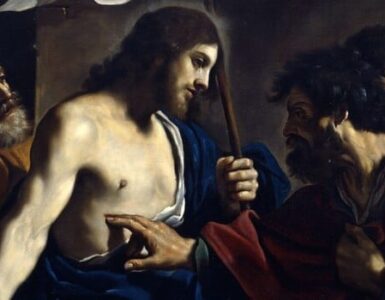Bishop Fulton Sheen said, “Only those who live by faith really know what is happening in the world; the great masses without faith are unconscious of the destructive processes going on, because they have lost the vision of the heights from which they have fallen.”
Isn’t it true? I’m amazed at what people fall for. But you won’t see the lies and destructive processes going on without faith—Bishop Sheen was correct.
The historical collision taking place in plain sight began as it always does, on the battlefield of the individual human heart between love and lust. The personal choices one makes are in turn manifested in the culture and ultimately the nation. It is a choice to build up either the city of man, in which man makes himself god, “we will be like god, deciding what is good and what is evil” (cf. Gen 3:5), or the city of God, where man acknowledges God and goes out to seek the truth, asking, “how then shall I live?”
A culture and in turn a nation does not exist without people. A particular culture, a uniquely human enterprise, is ultimately the united body or force of individual human hearts, coming together to create either a culture of life, love, truth, goodness, and beauty, or a culture of death, lust, lies, division, and the profane. The nation in turn is, in fact, the great community of men and women, who are united by various ties, but above all, by culture.1 The great community of men and women who form today’s culture were first educated and formed by culture. It is this community which possesses a history that goes beyond the history of the individual and the family,2 and that, in turn, is the foundation for a nation.
Today we are faced with a culture and a nation in crisis and decline. Ultimately, this is a crisis of individual human hearts, men and women, who have rejected objective truth and instead have embraced subjective constructs of individual thoughts and feelings.
Bishop Fulton Sheen, with a saintly long-ranging spiritual vision, saw the roots of this decline and today’s crisis firmly planted and growing in 1974 and warned of a crisis in Christendom. “First of all, we are at the end of Christendom,” he said solemnly during a television show. “Now not Christianity, not the Church, but Christendom that is economic, political and social life as inspired by Christian principals. That is ending—we’ve seen it die. Look at the symptoms: the breakup of the family, divorce, immorality, general dishonesty.”
That was 1974. Today we know it has gotten much worse.
Bishop Sheen reminded us that of the twenty-two major civilizations that have decayed since the beginning of human history, nineteen rotted and perished from within, “We live in it day to day, and do not see the decline.” Many people have a sense that something is terribly wrong but because they live day to day like the frog in the proverbial pot, consciences dulled by moral relativism, they have become apathetic to the evils of this present age. Consciences close to death, they are easily manipulated by anyone who appeals to their emotions with words such as being nice, kind, compassionate, and accepting of others regardless of what is objectively true, good, or beautiful. They have forgotten that being kind is not the same as love. That to love someone is to will their good, what is good for them.
This brief sketch presents us with a contrast between two opposing forces. One built upon all that is true, good, and beautiful, especially the beauty of love, the culture of life, and one built upon the shifting sands of lies, evil, and the profane, one especially opposed to authentic love, the culture of death.
What has become increasing clear is that the battle is intensifying. What many fail to understand is that the real battle is between our Lord and Satan. We are in a spiritual battle, and the forces led by Satan have as their primary goal the destruction of humanity.
The solution to this problem of evil? Saint John answers clearly, “The reason the Son of God appeared was to destroy the works of the devil” (1 John 3:8).
In Pope John Paul ll’s final message on April 3, 2005, he wrote,
To humanity, which at times seems to be lost and dominated by the power of evil, egoism and fear, the risen Lord offers as a gift his love that forgives, reconciles and reopens the spirit to hope. It is love that converts hearts and gives peace. How much need the world has to understand and accept Divine Mercy. Lord, who with (your) Death and Resurrection reveal the love of the Father, we believe in you and with confidence repeat to you today: Jesus, I trust in You, have mercy on us and on the whole world.
We have arrived at the crucial question concerning man and his destiny: How are we to understand the deepest meaning of history? Is it sufficient to adopt an approach to the question that remains within the limits of time and space?3
Human history obviously unfolds in a horizontal dimension within space and time. Yet it also has a vertical dimension. It is not only we who write our history; God writes with us.
In what way does God write our history? An answer is given in the Bible, from the Book of Genesis right up to the final pages of the Apocalypse. At the very beginning of human history, God reveals himself as the God of the promise.4 Immediately after the fall, the promise of the future plan of salvation is already contained in the curse addressed by God to the serpent. God curses the evil spirit, the instigator of the original sin of our first parents, but at the same time He utters words that express the first Messianic promise. He says to the serpent: “I will put enmity between you and the woman and between your offspring and hers; he will strike your head, and you will strike his heel” (Gen 3:15).5
This is the battle between truth and lies, good and evil, love and death, beauty and the profanity of beauty. It rages until the end of time. Yet already in Genesis, God is writing history in another way. God makes a promise to Abraham that was fulfilled. Gradually Abraham’s descendants grow into a nation. Israel is God’s chosen nation, to whom he promised a Messiah. The entire history of Israel is a time of waiting for God to carry out this promise.6
Then, in a particular place and time, the dramatic event in God’s plan of salvation takes place. His Son, Jesus Christ the Messiah, is born of a woman. With power, He ushers in the opposing force that will defeat sin and death once and for all. He is that force. “When I am lifted up from the earth, I will draw all people to myself” (John 12:32). “The whole world is under the power of the Evil One” (1 John 5:19). The victory which overcomes the world is our faith. “For whatever is born of God overcomes the world; and this is the victory that overcomes the world, our faith. Who is it that overcomes the world but he who believes that Jesus is the Son of God” (1 Jn 5:4).
John, the beloved apostle of our Lord, was not only full of confidence in the promises of his heavenly Master, but likewise endowed with the Spirit of prophecy when he announced with so much assurance the victory of Christian faith over a world fortified against its doctrines by inveterate prejudices and ready to come forward with all the means of resistance. What the apostle foretold came to pass.
The faith of Christ overcame the world. The doctrine of the Gospel enlightened mankind; the darkness and delusions of false religions faded before the resplendent light of Christianity; the Church of God rose conspicuous on their ruins and has always remained in the public profession of the same faith, in the teaching of the same doctrines, in the administration of the same sacraments, in the possession of the same ministry uninterruptedly derived from Christ and His apostles, in the offering of the same one, holy, adorable sacrifice to the Eternal Father, and in retaining its distinguishing and characteristic title of Catholic.7
Reading these divine words gives us the perfect awareness of what is really happening in the world, within human history, considered in its depths. The human story is a confrontation between two forces: the force of attraction, whose source is the wounded Heart of the Crucified Risen One, and the power of Satan, who does not want to be ousted from his kingdom.8
The area in which the confrontation takes place is the human heart; it is human liberty. And the confrontation has two dimensions: and interior dimension and an exterior dimension. Since man is not pure spirit, the human person is not solely interiority. Human interiority is expressed and manifested in construction of the society in which he or she lives. Human interiority is expressed and manifested in culture, as an essential dimension of human life as such. Culture is the mode of living which is specifically human. Given that man is positioned between two opposing forces, the condition he finds himself in must necessarily give rise to two cultures: the culture of the truth and life, or the culture of the lie and death.9
There is a voice that the faithful hear that the Tyrants of this present darkness have rejected.
And He who sat upon the throne said, “Behold, I make all things new.” And, “Write this, for these words of mine are trustworthy and true. And He said to me, “It is done! I am the Alpha and the Omega, the beginning and the end. To the thirsty I will give water without price from the fountain of the water of life. He who conquers shall have this heritage, and I will be his God and he shall be my son. But for the cowardly, the faithless, the polluted, as for murderers, fornicators, sorcerers, idolaters, and all liars, their lot shall be in the lake that burns with fire and brimstone, which is the second death” (Rev 21:5-8).
Listen and you will hear John Paul II’s voice calling out, encouraging us, “Be not afraid.”
Photo by Jeremy Bishop on Unsplash
1John Paul II, Memory and Identity, pg. 85.
2Ibid
3Memory and Identity, page. 153.
4Memory, pg. 153.
5Cf. Ibid, pgs. 154-55.
6Cf. Ibid, page 154.
7Archbishop Carroll († 1815) was a Jesuit priest and the first bishop of the United States. / Excerpts from American Jesuit Spirituality, The Maryland Tradition, 1634-1900, Robert Emmett Curran, s.j., Ed. © 1988, Paulist Press, Inc., New York/Mahwah, NJ.
8Cardinal Caffarra, address for the fourth annual Rome Life Forum, May 19, 2017.
9Cf. Ibid











